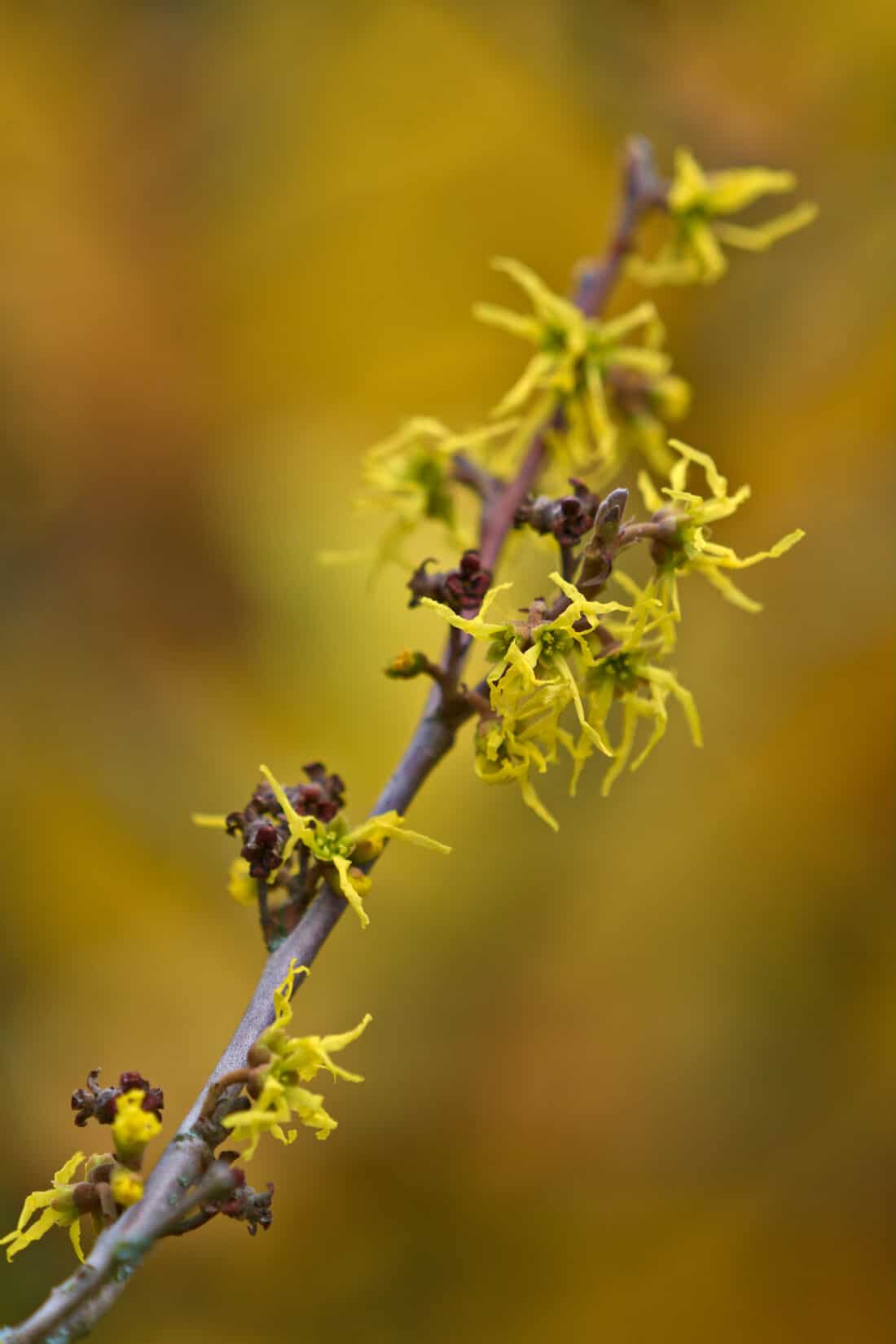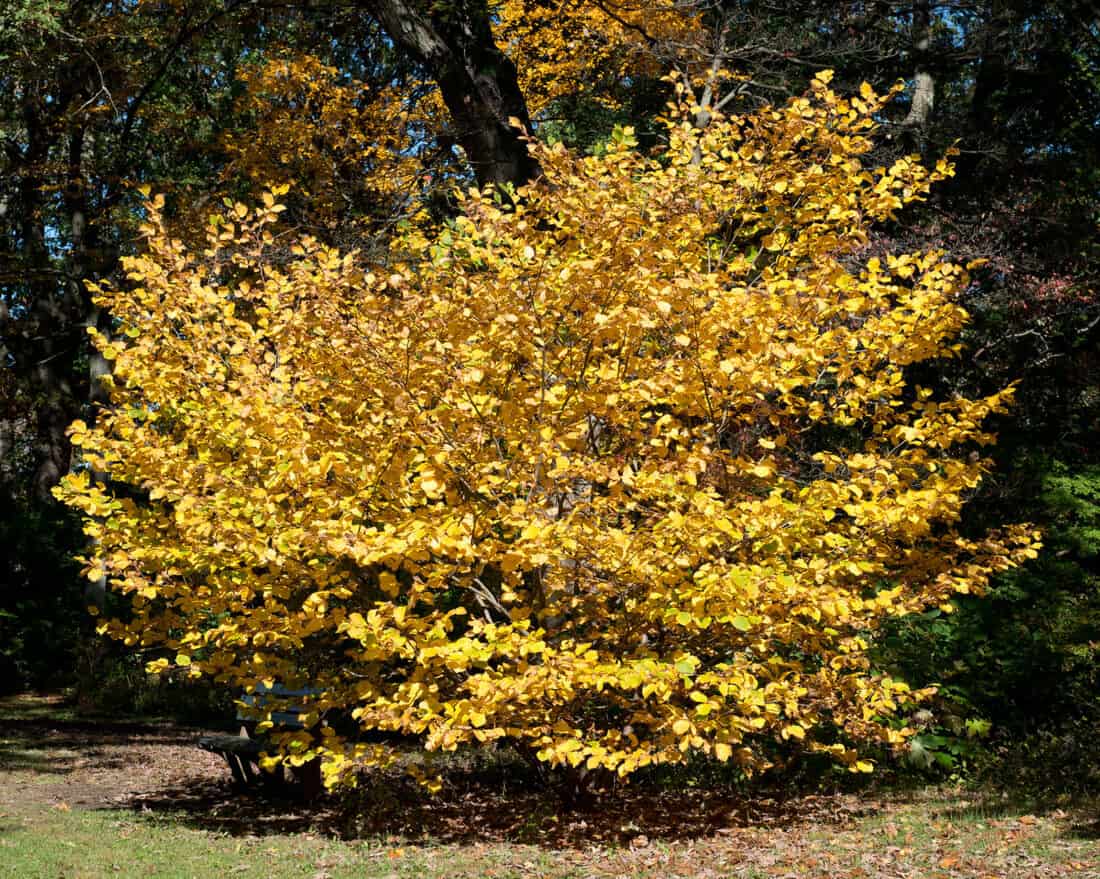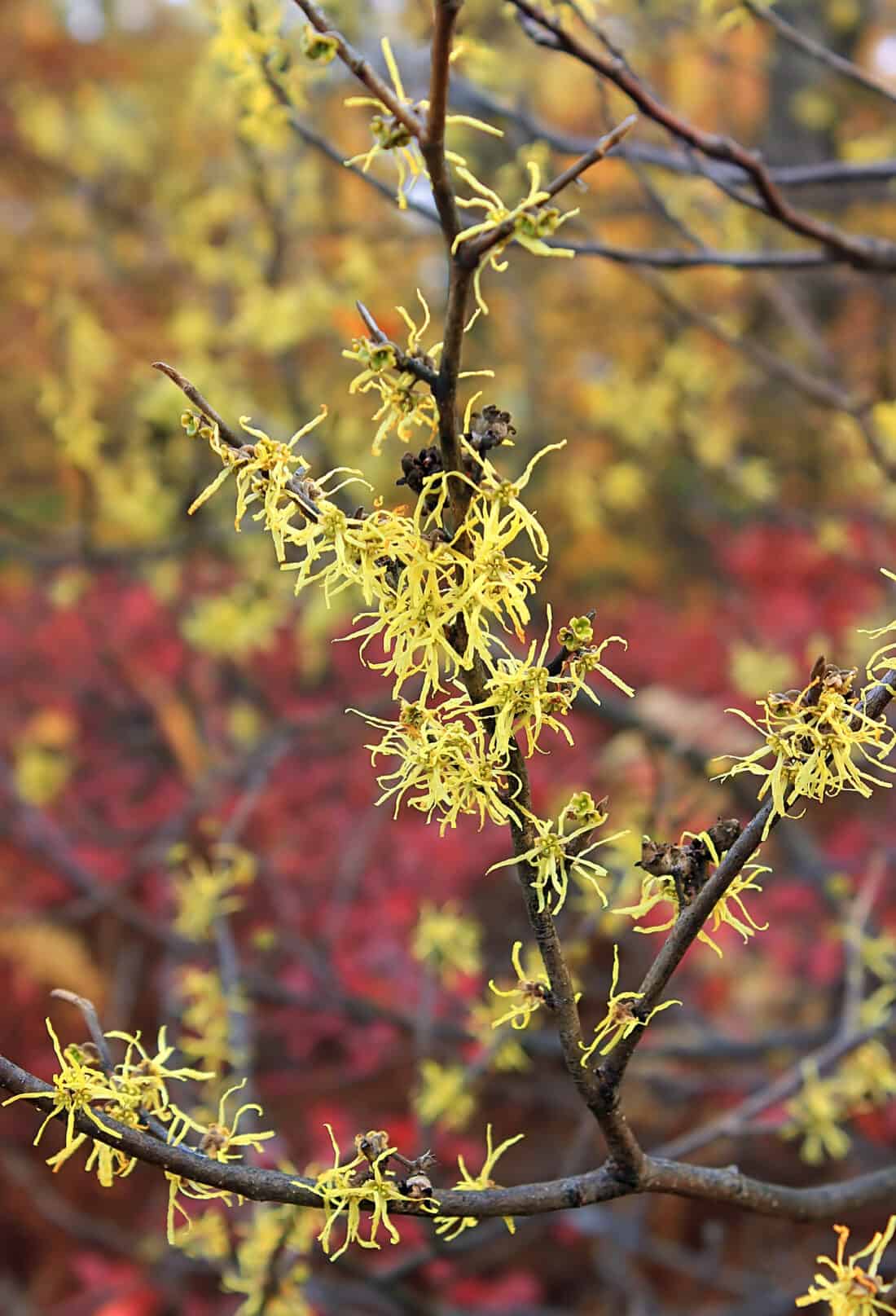I first fell in love with witch hazel in design school. Constantly walking the paths of Kew Gardens trying to take images of useful garden plants, it was inevitable that Witch Hazel was prominently featured in nearly all my classmate’s plant portfolios. It was one of the few plants reliably in bloom when nothing else was (i.e., very late fall and winter — when we were in school).
Most of the hamamelis varieties that I was observing in England were not, however, the North American Native witch hazel.

They were Hamamelis x intermedia, which is arguably the most popular hybrid variety. It has been bred extensively to exhibit a wide variety of flower colors and features. H. x intermedia is a cross between a Chinese native hamamelis mollis and a Japanese variety, Hamamelis japonica.
The Native North American Hamamellis variety
The North American native (hamamelis virginiana) is the common witch-hazel native to eastern North America. If you are a North American gardener and want to plant more natives. – this shrub is particularly spectacular in the fall. Many witch hazels have an attractive, sweet smell, and this one is no exception. In this case, you have to imagine its sweet smell combined with the typical scent of falling leaves and autumn mustiness. The combination is a great addition to the sensory pleasures of a fall garden.
Hamamelis virginiana is predominantly yellow-flowered, but there are many hazel varieties that feature all shades of yellows, oranges, and reds (these are the H. x intermedia varieties), all of which give the garden spectacular winter interest.
The shaggy blooms put on around November and stay through to late spring. You can see the yellow flowers through the bright yellow fall foliage, but as soon as the leaves fall away, you are left with sculptural twigs and funky flowers. And witch hazel blooms are an interesting sight. The flowers look more like squiggles dangling from bare stems – the ribbon-shaped petals hang in clusters.

Native vs. Non-Native Witch Hazel
The biggest difference between native common witch hazel and all the other non-native varieties is that H. virginiana is the only witch hazel that blooms in the fall rather than the winter (November – December blooms vs. Jan- March blooms).
All hazels are medium to large shrubs, and some varieties can also be considered small trees. (Growing to as much as 20 feet tall). As a deciduous shrub, you can expect that its dark green leaves will turn and shed in the autumn leaving the blooms to be visible on bare branches. They can grow in the full sun, but as natural understory trees, they are accustomed to part shade in the wild. The native varieties are often found lining stream banks and enjoy moist, well-drained soils, but they can be tolerant of heavy clay soils.
Design Uses for Native Hamamelis virginiana in the Garden
A collection of hamamelis makes a great open habit hedge. These are great plants to put toward the back of the border or as part of a windbreak. I have mine planted among a variety of other small trees – and it is the only one in the selection but I do think that this a plant that is best highlighted in a design that features a collection of them.
Alternatively, choose a specimen that is large enough to be a focal point when it blooming in the winter. Consider also putting it in front of an evergreen or a backdrop (perhaps your house or an outbuilding) that will make the flowers more visible.

Other Companion plants that I’d consider pairing Hazel it with:
- Fall-Blooming Perennials:
- Asters (Aster spp.): Choose late-blooming asters for a burst of color that coincides with witch-hazel’s fall bloom.
- Shade-Tolerant Ground Covers:
- Lamium (Lamium spp.): This low-growing, shade-tolerant ground cover offers variegated foliage and small, delicate flowers.
- Epimedium (Epimedium spp.): Also known as barrenwort, it thrives in the shade and provides attractive foliage.
- Ferns:
- Christmas Fern (Polystichum acrostichoides): Evergreen and deer-resistant, this fern adds texture and greenery to the garden.
- Spring-Blooming Bulbs:
- Daffodils (Narcissus spp.): Plant daffodils around witch-hazel for an early spring display before its leaves unfurl.
- Native Shrubs:
- Viburnum (Viburnum spp.): Choose native viburnums for their diverse foliage and berries, providing interest throughout the year.
- Ground Covers with Winter Interest:
- Pachysandra (Pachysandra procumbens.): An evergreen ground cover that provides coverage even in winter.
- Native Grasses and Perennial Grasses :
- Little Bluestem (Schizachyrium scoparium): A native grass with attractive seed heads that add interest to the fall and winter garden.
- Switchgrass (Panicum virgatum): Native switchgrass adds height and texture to the landscape.
- Heathers:
- Winter Heath (Erica carnea): Low-growing heathers provide winter color and contrast with witch-hazel’s fall bloom.
- Spring Ephemerals:
- Bloodroot (Sanguinaria canadensis): This spring ephemeral offers delicate white flowers and interesting foliage.
- Ground Covers for Moist Areas:
- Bugleweed (Ajuga reptans): Ideal for areas with moisture, bugleweed offers colorful foliage and low-growing habit.
- Fruit-Bearing Shrubs:
- Serviceberry (Amelanchier spp.): Native serviceberries provide seasonal interest with flowers, fruit, and fall color.
Witch Hazel Lore and Uses
Witch Hazel has many historical associations with witches and magic. It has been thought to protect one from witches, but people who are Pagan or Wicca also have many uses for the plant. The medieval English word whiche, meaning “flexible,” may have been correlated and applied to the characteristically flexible witch hazel branches.
Modern witches consider witch hazel a magical herb and utilize it in spells to guard against evil influences and to heal broken hearts. Dowsers or water witches use the forked branches of witch hazel to find subterranean water, lost items, or hidden treasures beneath the earth.
The Mohegans made balms out of the bark of witch hazel and used the leaves to make tea. The tea and balm were applied to cuts and wounds, and the tea was ingested to help treat menstrual problems, colds, and other ailments. Often still used today, this pretty woodland garden shrub has good kitchen and medicinal uses.
Witch hazel remains a popular ingredient in skincare products due to its astringent and anti-inflammatory properties. It is commonly used in toners, cleansers, and other topical solutions. The most commonly used variety in making Witch Hazel extracts and tonics is from the bark and roots of distilled Hamamelis. virginiana.
So funny, the coincidence. The first photos of Hamamellis sp. I have is from Kew in Feburary when I visited one year. Also proof that Dorothy was right…sometimes we need to travel far and wide to appreciate what we have right outside our own doorstep!